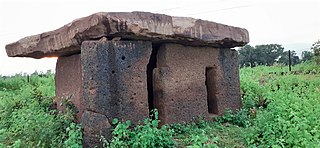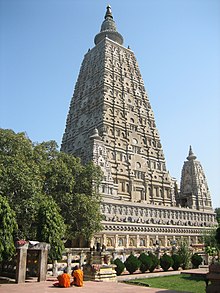
The Indus Valley Civilisation (IVC), also known as the Indus Civilisation, was a Bronze Age civilisation in the northwestern regions of South Asia, lasting from 3300 BCE to 1300 BCE, and in its mature form 2600 BCE to 1900 BCE. Together with ancient Egypt and Mesopotamia, it was one of three early civilisations of the Near East and South Asia, and of the three, the most widespread, its sites spanning an area from much of Pakistan, to northeast Afghanistan, and northwestern India. The civilisation flourished both in the alluvial plain of the Indus River, which flows through the length of Pakistan, and along a system of perennial monsoon-fed rivers that once coursed in the vicinity of the Ghaggar-Hakra, a seasonal river in northwest India and eastern Pakistan.

A megalith is a large stone that has been used to construct a prehistoric structure or monument, either alone or together with other stones. There are over 35,000 in Europe alone, located widely from Sweden to the Mediterranean sea.

Rakhigarhi or Rakhi Garhi is a village and an archaeological site belonging to the Indus Valley civilisation in Hisar District of the northern Indian state of Haryana, situated about 150 km northwest of Delhi. It was part of the mature phase of the Indus Valley Civilisation, dating to 2600-1900 BCE. It was among the largest settlements of the ancient civilisation, though most of it remains unexcavated. The site is located in the Ghaggar River plain, some 27 km from the seasonal Ghaggar river. Initial excavations at the site happened in the 1960s, followed by further excavations in the late 1990s, however more sustained excavations have taken place in the past decade.

Black and red ware (BRW) is a South Asian earthenware, associated with the neolithic phase, Harappa, Bronze Age India, Iron Age India, the megalithic and the early historical period. Although it is sometimes called an archaeological culture, the spread in space and time and the differences in style and make are such that the ware must have been made by several cultures.

The Ochre Coloured Pottery culture (OCP) is a Bronze Age culture of the Indo-Gangetic Plain "generally dated 2000–1500 BCE," extending from eastern Punjab to northeastern Rajasthan and western Uttar Pradesh.

The Painted Grey Ware culture (PGW) is an Iron Age Indo-Aryan culture of the western Gangetic plain and the Ghaggar-Hakra valley in the Indian subcontinent, conventionally dated c.1200 to 600–500 BCE, or from 1300 to 500–300 BCE It is a successor of the Cemetery H culture and Black and red ware culture (BRW) within this region, and contemporary with the continuation of the BRW culture in the eastern Gangetic plain and Central India.

The Northern Black Polished Ware culture is an urban Iron Age Indian culture of the Indian subcontinent, lasting c. 700–200 BCE, succeeding the Painted Grey Ware culture and Black and red ware culture. It developed beginning around 700 BCE, in the late Vedic period, and peaked from c. 500–300 BCE, coinciding with the emergence of 16 great states or Mahajanapadas in Northern India, and the subsequent rise of the Mauryan Empire.

Amri is an ancient settlement in modern-day Sindh, Pakistan, that goes back to 3600 BCE. The site is located south of Mohenjo Daro on Hyderabad-Dadu Road more than 100 kilometres north of Hyderabad, Pakistan.

In the prehistory of the Indian subcontinent, the Iron Age succeeded Bronze Age India and partly corresponds with the megalithic cultures of India. Other Iron Age archaeological cultures of India were the Painted Grey Ware culture and the Northern Black Polished Ware. This corresponds to the transition of the Janapadas or principalities of the Vedic period to the sixteen Mahajanapadas or region-states of the early historic period, culminating in the emergence of the Maurya Empire towards the end of the period.
Amri–Nal culture is attributed to Amri archaeological sites in Sindh and Balochistan provinces of Pakistan. It flourished in the 4th and 3rd millennia BC. The dual typesites are Amri and Sohr Damb area in Naal, Balochistan.

Pottery in the Indian subcontinent has an ancient history and is one of the most tangible and iconic elements of Indian art. Evidence of pottery has been found in the early settlements of Lahuradewa and later the Indus Valley Civilisation. Today, it is a cultural art that is still practiced extensively in the subcontinent. Until recent times all Indian pottery has been earthenware, including terracotta.
Banawali is an archaeological site belonging to Indus Valley civilization period in Fatehabad district, Haryana, India and is located about 120 km northeast of Kalibangan and 16 km from Fatehabad. Banawali, which is earlier called Vanavali, is on the left banks of dried up Sarasvati River. Comparing to Kalibangan, which was a town established in lower middle valley of dried up Sarasvathi River, Banawali was built over upper middle valley of Sarasvati River.

Bhirrana, also Bhirdana and Birhana, is an archaeological site, located in a small village in the Fatehabad district of the north Indian state of Haryana. Bhirrana's earliest archaeological layers predates the Indus Valley civilisation times, dating to the 8th-7th millennium BCE. The site is one of the many sites seen along the channels of the seasonal Ghaggar river, thought by some to be the Rigvedic Saraswati river.
Brahmagiri is an archaeological site located in the Chitradurga district of the state of Karnataka, India. Legend has it that this is the site where sage Gautama Maharishi and his wife Ahalya lived. He was one among seven noted Hindu saints. This site was first explored by Benjamin L. Rice in 1891, who discovered rock edicts of Emperor Ashoka here. These rock edicts indicated that the locality was termed as Isila and denoted the southernmost extent of the Mauryan empire. The Brahmagiri site is a granite outcrop elevated about 180 m. above the surrounding plains and measures around 500 m east-west and 100 m north-south. It is well known for the large number of megalithic monuments that have been found here. The earliest settlement found here has been dated to at least the 2nd millennium BC.
Kunal is a pre-Harappan Indus Valley civilisation settlement located, just 30 km from Fatehabad City in Fatehabad district of Haryana state in India. Compared to other IVC sites, such as cities like Rakhigarhi and towns like Kalibangan, Kunal site was a village. Excavation at Kunal show 3 successive phases of Pre-Harappan indigenous culture on the Saraswati river who also traded with Kalibanga and Lothal. Kunal, along with its other contemporary sites Bhirrana and Rakhigarhi on Sarasvati-Ghaggar river system, is recognised as the oldest Pre-Harappan settlement, with Kunal being an older cultural ancestor to Rehman Dheri in Pakistan< which is on the Tentative List for future World Heritage Sites.

The stone circles of Junapani are prehistoric megalithic circles in Junapani, near Nagpur in the Indian state of Maharashtra. There are about 300 such stone circles noted around Junapani. They were first excavated by J. H. Rivett-Carnac in 1879, yielding a variety of iron objects including daggers, flat axes with cross-ring fasteners, hoes, rings, bracelets, horse bits, chisels with long blades, and pointed tongs, possibly covered with a wooden handle. There is also evidence of black and red pottery, such as bowls featuring linear paintings in black. The burial sites were characterized by cairns. About 150 stone circles have been studied and documented. A notable feature is the cup-marked stones in the circles which seem to suggest an astronomical significance. This aspect has been discerned from the fact that the cup-marked stones are fixed at specific locations denoting specific directions.

Hakra Ware culture was a material culture which is contemporaneous with the early Harappan Ravi phase culture of the Indus Valley in Northern India and eastern-Pakistan. This culture arises in the 4th millennium with the first remnants of Hakra Ware pottery appearing near Jalilpur on the Ravi River about 80 miles (130 km) southwest of Harrappa in 1972. Along with this, numerous other areas including Kunal, Dholavira, Bhirrana, Girwas, Farmana and Rakhigarhi areas of India contained Hakra Ware pottery.

Sohr Damb, c. 3800–2300 BC, is an archaeological site, located near Nal, in central Balochistan, Pakistan that begins before the Indus Valley civilization featuring Togau, Kili Ghul Mohammad, and Kechi Beg pottery styles. It has also been known as Naal, Balochistan, and gave its name to the prehistoric Amri-Nal culture, which is attributed to the dual typesites of Amri and Nal.

Hirapur dolmens, dating back to 2nd-3rd century BC asmaka mahajanapadas or satavahana dynasty era, are 4 dolmens made of megalithic laterite in the general area of Hirapur village on NH-930 in Chimur tehsil of Chandrapur district of Maharashtra.
















